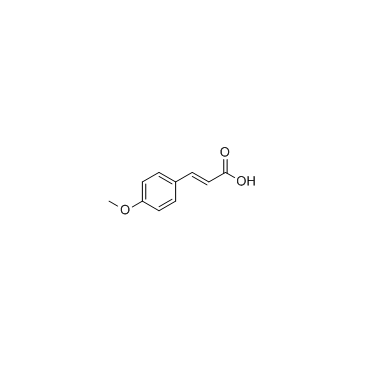4-Methoxycinnamic acid

4-Methoxycinnamic acid structure
|
Common Name | 4-Methoxycinnamic acid | ||
|---|---|---|---|---|
| CAS Number | 830-09-1 | Molecular Weight | 178.185 | |
| Density | 1.2±0.1 g/cm3 | Boiling Point | 342.6±17.0 °C at 760 mmHg | |
| Molecular Formula | C10H10O3 | Melting Point | 173.5 °C(lit.) | |
| MSDS | Chinese USA | Flash Point | 138.6±14.4 °C | |
| Symbol |

GHS07 |
Signal Word | Warning | |
|
A metabolite profiling approach to identify biomarkers of flavonoid intake in humans.
J. Nucl. Med. 139 , 2309-14, (2009) Flavonoids are phytochemicals that are widespread in the human diet. Despite limitations in their bioavailability, experimental and epidemiological data suggest health benefits of flavonoid consumption. Valid biomarkers of flavonoid intake may be useful for e... |
|
|
Structure-activity relationships of 1'S-1'-acetoxychavicol acetate for inhibitory effect on NO production in lipopolysaccharide-activated mouse peritoneal macrophages.
Bioorg. Med. Chem. Lett. 15 , 1949-53, (2005) 1'S-1'-Acetoxychavicol acetate from the rhizomes of Alpinia galanga inhibited nitric oxide (NO) production in lipopolysaccharide-activated mouse peritoneal macrophages with an IC(50) value of 2.3 microM. To clarify the structure-activity relationship of 1'S-1... |
|
|
Structure-activity relationships of trans-substituted-propenoic acid derivatives on the nicotinic acid receptor HCA2 (GPR109A).
Bioorg. Med. Chem. Lett. 21 , 2736-9, (2011) Nicotinic acid (niacin) has been used for decades as an antidyslipidemic drug in man. Its main target is the hydroxy-carboxylic acid receptor HCA2 (GPR109A), a G protein-coupled receptor. Other acids and esters such as methyl fumarate also interact with the r... |
|
|
Inhibitory effects of 5-benzylidene barbiturate derivatives on mushroom tyrosinase and their antibacterial activities.
Eur. J. Med. Chem. 44 , 4235-43, (2009) A series of novel 5-benzylidene barbiturate and thiobarbiturate derivatives were synthesized and evaluated as tyrosinase inhibitors and antibacterial agents. The results demonstrated that some compounds had more potent inhibitory activities than the parent co... |
|
|
Synthesis and biological evaluation of helicid analogues as mushroom tyrosinase inhibitors.
Bioorg. Med. Chem. Lett. 18 , 6490-3, (2008) A series of helicid analogues were synthesized and evaluated as tyrosinase inhibitors. The results demonstrated that some compounds had more potent inhibitory activities than arbutin (IC(50) 7.3 mM). In particular, compound 1c bearing 4,6-O-benzylidene substi... |
|
|
Synthesis and biological evaluation of novel 4-hydroxybenzaldehyde derivatives as tyrosinase inhibitors.
Eur. J. Med. Chem. 45 , 639-46, (2010) A series of novel 4-hydroxybenzaldehyde derivatives were synthesized and their inhibitory effects on the diphenolase activity of mushroom tyrosinase were investigated. Most of target compounds had more potent inhibitory activities than the parent compound 4-h... |
|
|
A practical procedure for the large-scale preparation of methyl (2R,3S)-3-(4-methoxyphenyl)glycidate, a key intermediate for diltiazem.
J. Org. Chem. 67(13) , 4599-601, (2002) A practical synthesis of methyl (2R,3S)-3-(4-methoxyphenyl)glycidate (-)-2, a key intermediate for diltiazem (1), was developed. Treatment of methyl (E)-4-methoxycinnamate 3 with chiral dioxirane, generated from chiral ketone 4, provided (-)-2 in 77% ee and 8... |
|
|
Synthesis and structure-activity relationships of phenylpropanoid amides of serotonin on tyrosinase inhibition.
Bioorg. Med. Chem. Lett. 21 , 1983-6, (2011) In this manuscript, we synthesized a series of phenylpropanoid amide of serotonin 1-9, analyzed their structural importance for two biologic activities (antioxidant activity and tyrosinase inhibitory activity). While the serotonin moiety and the amide linkage... |
|
|
1-(1-Arylethylidene)thiosemicarbazide derivatives: a new class of tyrosinase inhibitors.
Bioorg. Med. Chem. 16 , 1096-102, (2008) A series of 1-(1-arylethylidene)thiosemicarbazide compounds and their analogues were synthesized and characterized by 1H NMR, MS. Their tyrosinase inhibitory activities were investigated by an assay based on the catalyzing ability of tyrosinase for the oxidat... |
|
|
Enzymatic synthesis of cinnamic acid derivatives.
Biotechnol. Lett. 28(8) , 581-5, (2006) Using Novozym 435 as catalyst, the syntheses of ethyl ferulate (EF) from ferulic acid (4-hydroxy 3-methoxy cinnamic acid) and ethanol, and octyl methoxycinnamate (OMC) from p-methoxycinnamic acid and 2-ethyl hexanol were successfully carried out in this study... |